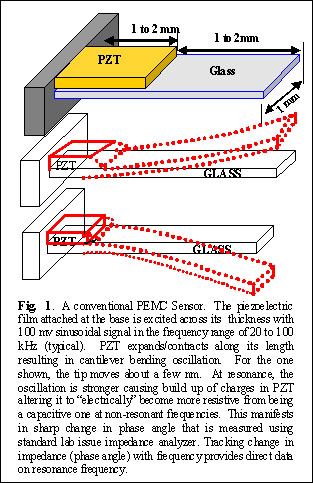How does a piezoelectric-excited cantilever sensor sense?

| |
Principle of operation of a piezoelectric-excited cantilever sensor is illustrated schematically in Fig 1. It is a macro-cantilever that comprises of a PZT (lead zirconate titanate) layer bonded to a non-piezoelectric layer of a few millimeters in length and 1 mm in width. The PZT layer of the cantilever serves both as an actuating and as a sensing element. When an electric field is applied across the thickness of the PZT layer, it deforms primarily along its length causing the base non-piezoelectric layer to flex as shown in the figure. If the field alternates, the sensor experiences flexural oscillations. The sensor resonates when the excitation frequency coincides with the natural frequency (mechanical) of the cantilever beam. At resonance, the cantilever undergoes higher than normal bending stresses and the PZT being electro-mechanically active exhibits a sharp change in electrical impedance. In other words, the phase angle between the excitation voltage and the resulting current changes significantly and is conveniently measured by a laboratory impedance analyzer. The sensing response is obtained by measuring changes in resonance frequency of the vibrating sensor as target analyte binds to sensor surface. A detailed discussion on sensing principle of a PEMC is given in one of our early publications1, and mathematical models describing mechanical resonance frequency of various cantilever beams have been reported by several researchers2, 3.
|
|